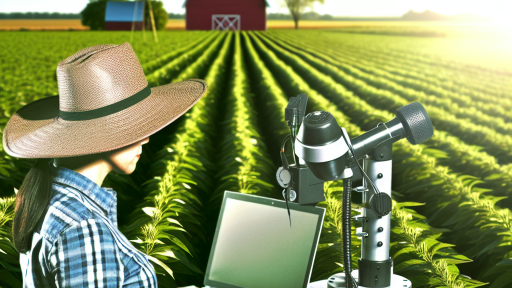Understanding the Benefits of Cover Crops in Sustainable Agriculture
Enhancing Soil Health
Cover crops significantly improve soil health.
They enhance soil structure by adding organic matter.
Moreover, these crops prevent soil erosion effectively.
Healthy soils retain moisture better, which aids plants.
Additionally, cover crops boost soil fertility through nitrogen fixation.
Promoting Biodiversity
Cover crops foster greater biodiversity in agricultural ecosystems.
They provide habitats for various beneficial organisms.
Furthermore, increased biodiversity enhances pest management.
Diverse root systems also improve soil penetration and aeration.
Reducing Weeds
Cover crops suppress weed growth naturally.
Their thick biomass prevents sunlight from reaching weed seeds.
Consequently, this reduces herbicide reliance and costs.
Moreover, cover crops can outcompete weeds for nutrients.
Managing Water
Cover crops play an essential role in water management.
They improve water infiltration rates in the soil.
Transform Your Agribusiness
Unlock your farm's potential with expert advice tailored to your needs. Get actionable steps that drive real results.
Get StartedThis reduces surface runoff and preserves moisture.
Additionally, cover crops can help mitigate flooding risks.
Economic Benefits
Implementing cover crops can lead to economic savings.
Farmers experience reduced input costs on fertilizers.
They also see improved crop yields in subsequent seasons.
Furthermore, healthier soils lead to lower management costs.
Complementing Crop Rotation
Cover crops seamlessly integrate with crop rotation practices.
They enhance the benefits of crop rotation by adding diversity.
This practice disrupts pest and disease cycles effectively.
Additionally, cover crops can be used as green manures.
Selecting the Right Cover Crop Species for Your Soil and Climate
Understanding Your Soil Type
Identifying your soil type is crucial.
Different cover crops thrive in various soil conditions.
For instance, sandy soils may require different crops than clay soils.
Conduct soil tests to determine pH and nutrient levels.
Each test provides information essential for selecting cover crops.
Climate Considerations
Your climate significantly impacts cover crop selection.
Consider factors like frost dates and rainfall patterns.
Some species handle cold well, while others prefer warmer temperatures.
Research native cover crops to ensure compatibility with local conditions.
Matching Cover Crop Functions to Goals
Determine your primary goals for using cover crops.
Are you looking to improve soil health or manage weeds?
Certain species excel in specific functions, such as nitrogen fixation.
Choose crops that align with your agricultural objectives.
Popular Cover Crop Species
Various species of cover crops thrive in specific conditions.
Showcase Your Farming Business
Publish your professional farming services profile on our blog for a one-time fee of $200 and reach a dedicated audience of farmers and agribusiness owners.
Publish Your Profile- Legumes such as clover and vetch enhance nitrogen levels.
- Brassicas like radishes break up compact soil.
- Grasses such as rye offer excellent erosion control.
Local Resources and Expertise
Consult local agricultural extension offices for advice.
These resources provide valuable information on cover crop selection.
Furthermore, local farmers may share their experiences.
Networking can enhance your understanding of effective choices.
Effective Seeding Techniques for Successful Cover Crop Establishment
Understanding the Importance of Cover Crops
Cover crops play a vital role in enhancing soil health.
They improve nutrient cycling and reduce soil erosion.
Additionally, cover crops can suppress weeds and pests.
Selecting the Right Cover Crop Species
Choosing the right species is crucial for success.
Consider factors such as climate, soil type, and rotation plans.
Popular choices include clover, rye, and vetch.
Ensure selected species meet your specific farming needs.
Timing for Optimal Seeding
Timing significantly impacts the establishment of cover crops.
Plant cover crops immediately after cash crops are harvested.
This practice maximizes growth before winter frost.
Conversely, some species benefit from early spring planting.
Seed Bed Preparation Techniques
Proper seed bed preparation enhances seed-to-soil contact.
Start by tilling the soil to create a fine seed bed.
You can also use no-till methods for minimal disturbance.
Ensure the seed bed is firm to avoid air pockets.
Seeding Methods and Equipment
Choose an appropriate seeding method based on your farm.
Drills or broadcast methods are commonly used.
Row spacing should accommodate the growth habits of the species.
Adjust seeding depth according to the seed type for best results.
Monitoring and Adjusting Seed Rates
It’s essential to monitor your cover crop establishment regularly.
Adjust seed rates based on the germination success and soil fertility.
Keep an eye out for any signs of disease or pest pressure.
Post-Seeding Management Practices
After sowing, manage the cover crop for optimal growth.
Regularly check moisture levels and adjust irrigation accordingly.
Control any competing weeds to avoid resource competition.
Evaluating Cover Crop Success
Once the crops are established, evaluate their performance.
Assess benefits to soil health, nutrient levels, and biodiversity.
Gather data to inform future cover crop decisions.
Learn More: Automated Crop Monitoring Systems For Farmers
Timing Cover Crop Planting and Termination for Optimal Results
Importance of Timing
Timing plays a crucial role in cover crop management.
Proper timing maximizes the benefits of cover crops.
It influences soil health, nutrient cycling, and weed suppression.
Accurately timing planting and termination increases crop yield.
Planting Cover Crops
Choose the right time to plant cover crops based on your region.
Spring and fall are common planting seasons.
Seeding after primary crop harvest allows for optimal growth.
Showcase Your Farming Business
Publish your professional farming services profile on our blog for a one-time fee of $200 and reach a dedicated audience of farmers and agribusiness owners.
Publish Your ProfileMonitor soil moisture levels to inform planting decisions.
Utilizing weather forecasts can further enhance timing accuracy.
Recommended Planting Dates
- Late summer for fall cover crops.
- Early spring for summer cover crops.
- Mid to late August is ideal for many regions.
Termination of Cover Crops
Timely termination is essential for achieving desired outcomes.
Termination before planting cash crops prevents competition for nutrients.
Know the best timing for your specific cover crop species.
Incorporate cover crops into the soil for maximum benefits.
Techniques for Termination
- Mechanical methods, such as mowing or tilling.
- Chemical methods, using herbicides for effective termination.
- Rolling or crimping to suppress growth without tillage.
Monitoring and Adjusting
Regularly assess the growth and health of cover crops.
Adjust planting and termination strategies based on observations.
Each growing season offers new lessons and insights.
Keep detailed records to refine practices over time.
Delve into the Subject: Precision Agriculture Techniques For Modern Farmers
Managing Nutrient Cycling and Soil Health with Cover Crops
Importance of Nutrient Cycling
Nutrient cycling is vital for sustainable agriculture.
It enhances soil fertility and promotes plant health.
Cover crops effectively improve nutrient availability.
They prevent nutrient leaching during off-seasons.
Cover crops can also fix atmospheric nitrogen.
This process enriches the soil for subsequent crops.
Enhancing Soil Structure
Healthy soil structure supports root development.
Cover crops improve soil porosity and reduce compaction.
Their roots help bind soil particles together.
As these crops decompose, they add organic matter.
This organic matter enhances soil’s water retention capabilities.
Promoting Soil Microbial Activity
Cover crops boost the population of beneficial microbes.
These organisms play a crucial role in nutrient breakdown.
Moreover, they enhance nutrient cycling processes.
This increased microbial activity improves soil health.
As a result, crops benefit from better nutrient uptake.
Managing Erosion and Runoff
Soil erosion can severely impact agriculture.
Cover crops provide ground cover to protect the soil.
They reduce surface runoff during heavy rains.
You can establish deep-rooted cover crops to stabilize the soil.
This practice reduces soil loss and enhances resilience.
Best Practices for Implementing Cover Crops
Choose the right cover crops based on your soil conditions.
Annual species can provide quick benefits.
In contrast, perennial species enhance long-term soil health.
Timing of planting and termination is crucial.
Plan these activities to maximize nutrient capture.
Monitor your cover crops to assess their performance.
Adapt your strategies based on observed results.
You Might Also Like: Implementing Quality Control in Post-Harvest Steps
Showcase Your Farming Business
Publish your professional farming services profile on our blog for a one-time fee of $200 and reach a dedicated audience of farmers and agribusiness owners.
Publish Your Profile
Integrating Cover Crops into Crop Rotation Systems
Understanding Crop Rotation
Crop rotation involves regularly changing the type of crops grown in a specific area.
This practice enhances soil health and reduces pest problems.
Cover crops can fit seamlessly into crop rotation systems.
They provide numerous benefits, including improved soil structure and fertility.
Choosing the Right Cover Crops
Selecting suitable cover crops is essential for effective integration.
Consider factors such as climate, soil type, and cash crop rotations.
Legumes like clover can enhance nitrogen levels in the soil.
Non-legume options, such as rye, can help control erosion and suppress weeds.
Timing and Management Techniques
Timing plays a crucial role in the success of cover crops.
Plan planting times to maximize growth before cash crops are sown.
Monitor soil moisture levels to determine the best time for planting.
Utilizing practices such as no-till can minimize soil disturbance.
Benefits of Cover Crop Integration
Integrating cover crops offers several key advantages.
- Enhances soil health by improving organic matter content.
- Reduces soil erosion through root systems that stabilize the soil.
- Suppresses weeds, minimizing competition for resources.
- Improves nutrient cycling, benefiting subsequent cash crops.
Case Studies of Successful Integration
Several farmers have successfully integrated cover crops into their systems.
For instance, Sarah Williams used clover cover crops in her corn rotation.
She observed improved yields and reduced fertilizer needs.
Another example is Mark Thompson, who used rye after soybean harvests.
His soil health significantly improved, and his weed pressure decreased.
Challenges and Solutions
Integrating cover crops comes with its challenges.
Some farmers worry about the expense and labor involved.
However, the long-term benefits often outweigh these concerns.
Utilizing funding programs can help offset initial costs.
Additionally, educating farmers on management techniques can ease concerns.
Future Considerations
Looking ahead, research will continue to refine cover crop strategies.
New technologies may enhance planting and termination processes.
Farmers must stay informed about advancements to optimize their practices.
Furthermore, collaboration among farmers can foster shared solutions.
Learn More: Temperature Control Strategies for Storage Facilities
Addressing Common Challenges in Cover Crop Management
Identifying Soil Health Issues
Soil health issues can hinder effective cover crop management.
Farmers should regularly test soil for fertility levels.
Moreover, understanding soil structure and compaction is essential.
This knowledge aids in selecting the right cover crops.
Managing Cover Crop Selection
Selecting the right cover crop is critical for success.
Farmers must consider climate, soil type, and cropping systems.
Additionally, collaboration with agronomists can provide valuable insights.
They can recommend species that enhance soil health and biodiversity.
Addressing Erosion and Compaction
Erosion and soil compaction pose significant challenges.
Cover crops can help reduce soil erosion effectively.
Choosing deep-rooted crops can alleviate compaction issues.
Farmers should incorporate practices to monitor soil conditions regularly.
Showcase Your Farming Business
Publish your professional farming services profile on our blog for a one-time fee of $200 and reach a dedicated audience of farmers and agribusiness owners.
Publish Your ProfileOvercoming Pest and Disease Management
Pests and diseases can threaten cover crop success.
Farmers need to implement integrated pest management strategies.
Regular scouting can help identify pest problems early.
Additionally, crop diversity can reduce the risk of disease outbreaks.
Balancing Nutrient Management
Nutrient management is crucial for effective cover crop growth.
Farmers should assess nutrient availability in the soil.
Applying proper fertilization can enhance cover crop performance.
Moreover, incorporating legumes can naturally fix nitrogen in the soil.
Ensuring Proper Termination Timing
Timing the termination of cover crops is essential.
Terminating too early or too late can negatively impact subsequent crops.
Farmers must monitor growth stages to ensure optimum timing.
Consequently, they can maximize benefits for the following crop rotation.
Implementing Cost-Effective Solutions
Cost management is vital for sustainable cover crop practices.
Farmers can explore funding opportunities and grants to support initiatives.
Additionally, sharing resources with neighboring farms can reduce expenses.
Collaborative purchasing can also lead to reduced input costs.
Evaluating the Economic Impact of Cover Crop Practices
Understanding Cost Savings
Cover crops reduce overall production costs for farmers.
They help minimize the need for chemical fertilizers.
Farmers can benefit from lower input costs over time.
Additionally, cover crops enhance soil health, leading to better yields.
Assessing Increased Yields
Studies show that cover crops can increase crop yields.
Higher yields translate directly into increased revenue for farmers.
For example, farmers utilizing cover crops reported up to a 20% yield increase.
Long-term Economic Benefits
Investing in cover crops promotes sustainability in farming.
Soil health improvements lead to long-term productivity gains.
Moreover, healthier soils are more resilient to climate impacts.
Farmers may see lower costs related to soil erosion and degradation.
Market Opportunities
Utilizing cover crops can open new market opportunities.
Farmers can tap into organic markets by improving soil health.
Additionally, consumers increasingly favor sustainable farming practices.
Challenges and Considerations
Implementing cover crops comes with initial costs.
Farmers must consider the value of their time and resources.
Moreover, integrating cover crops may require changes in farming techniques.
However, the long-term advantages often outweigh these challenges.




